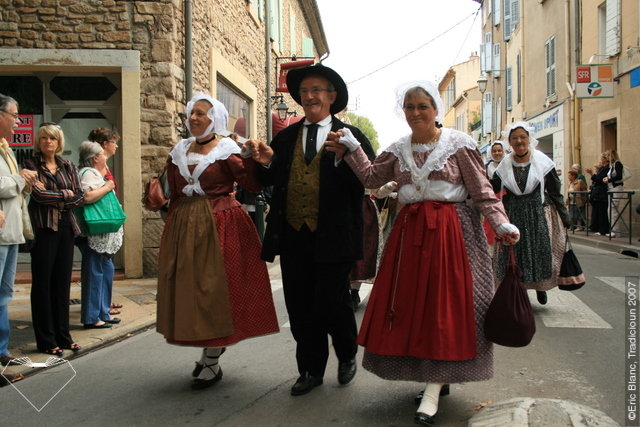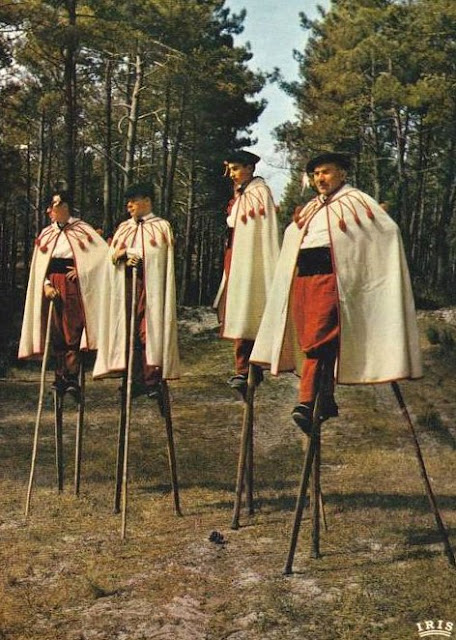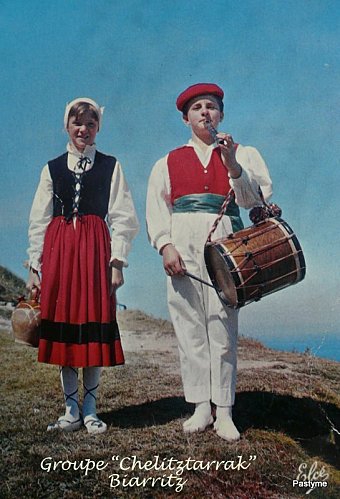This is a continuation of my last article.
France was divided into traditional provinces before the revolution. These are shown in color in the map above. Afterwards the nation was divided into administrative districts, called Departements, of roughly the same size, which were grouped into 27 Regions. These are shown by the fine and bold lines on the map above. A quick glance will show that they do not always correspond. The map below names the contemporary Regions and Departements.
I will attempt to present the folk costumes according to the old Provinces, as they more closely present regions of traditional culture.
France is, like most nations, multiethnic and multilingual. The five corners of the nation have territories in which unrelated languages are spoken. German in Alsace, Dutch in French Flanders, Breton in Brittany, Basque in the Basque country, and Catalonian in Rousillon. The Corsican language is also distinct. In the main part of the country various Romance dialects were traditionally spoken, which linguists and tradition group into three languages. In the north, the Langues d'oïl, https://en.wikipedia.org/wiki/Langues_d%27o%C3%AFl
these dialects are various forms of the language which we today call French.
In the east, Arpitan, https://en.wikipedia.org/wiki/Franco-Proven%C3%A7al_language
and in the south, the Langues d'oc, or Occitan. https://en.wikipedia.org/wiki/Occitan_language
On the following map, French dialects are shown in shades of green, Arpitan dialects in shades of blue, and Occitan dialects in shades of red. Other languages are shown in violet or lavender.
This article will cover roughly the territory of the Langues d'Oc and Arpitan, with the exception of Bresse. Aunis and Saintonge will be included int this article. I will proceed roughly from north to south. Some Provinces have much more material as regards costume than others.
Many of the costumes are quite similar, the largest differences being in the coifs and other headdresses, which show an amazing variety.
Aunis
This province, together with Saintonge, forms the current departement of Charentes Maritimes.
https://en.wikipedia.org/wiki/Aunis
In this province there are many coifs used. Poitou and Charentes are incredibly rich in different coifs. One of the major ones in Aunis is called the Capot Marandais. This consists of a triangular headpiece, and lace pieces which wrap around it, Similar to the Grisette of Niort.
This type is called la Rochelle.
But others are worn in the same region.
The most spectacular version of the coif is part of the traditional bridal wear of the Ile de Re.
Saintonge
This is an old province well known for its pottery.
https://en.wikipedia.org/wiki/Saintonge
The island of Oleron.
One famous version of the capot marandaise which is worn here is known as the ballon.
Other types of headpieces were also worn in this province.
This hat was worn with work clothing, as a protection against sun and weather.
This is called the coiffette.
A quadrille in 5 figures from Saintonge.
https://www.youtube.com/watch?v=OXLCr28UdoM
Angoumois
The most famous part of this province is the region of Cognac, which, of course, is known for its fine brandy.
https://en.wikipedia.org/wiki/Angoumois
The ballon and other coifs were worn here, but one of the distinctive coifs of this area is called le champanais, which was worn in the region around the town of Cognac.
La Marche
This province was once an independent county, that is, a region ruled by a Count.
https://en.wikipedia.org/wiki/County_of_La_Marche
The small straw hat with velvet ribbons is typical for this province, although similar to those found in parts of Auvergne.
A song from La Marche.
Limousin
The large luxury vehicle is named after this province. Originally the driver sat under an open roof, or hood, which supposedly resembled the headpiece of this region. Such are the vagaries of language.
https://en.wikipedia.org/wiki/History_of_Limousin
The distinctive coif of this region is called the barbichet. It is found only in this province.

https://www.youtube.com/watch?v=r_E5nAONYKA&index=6&list=PL71A052E80A660C44
Here is a dance from Limousin, La montagnard, three of the women are wearing wonderful Limousin costumes.
https://www.youtube.com/watch?v=nJL5y89Ls_4
Auvergne
Auvergne was the territory of the Gallic tribe of the Arverni. Under the leadership of the famous Vercingetorix, they won significant battles against Caesar in his attempt to conquer Gaul. The people of this region continue to take pride in their identity.
https://en.wikipedia.org/wiki/Auvergne_(province)
Auvergne is a region which has kept much of its traditional culture, including music and dance.
https://www.youtube.com/watch?v=a0j9dTBJWWE
Lyonnais
This province consists of the land around the City of Lyons. It forms the contemporary departements of Rhone and Loire.
https://en.wikipedia.org/wiki/Lyonnais
http://mprni.blogspot.com/2017/02/costumes-lyonnais.html
Savoie
Savoy was an independent Duchy for many centuries and was only incorporated into France after the Revolution. It has very strong local traditions in many ways.
https://en.wikipedia.org/wiki/Savoy
Savoy is currently divided into two departements, Savoie and Haute-Savoie, or Upper Savoy. The costumes of this region are very rich, especially in the southern part. This region lies in the French Alps
Haute Savoie
Annecy is the capitol of Upper Savoy and lies in the west part of the departement.
A traditional wedding in Annecy.
https://www.youtube.com/watch?v=c0BawsntShs
Chablais lies in the northeast of Upper Savoy, next to the present Swiss border. This costume is from the Morzine valley.
Grand Bornand lies in the central part of this area, on the Borne river. Note the hand embroidered shawls.
Val Montjoie is in southeast Upper Savoy. The mountains to its south block access to Savoy proper.
Some dances from Upper Savoy.
https://www.youtube.com/watch?v=GjKHUfHQkt0
Savoie
This area is extremely rich in folk costumes, and I have already done a series of articles about the costumes of this area.
http://folkcostume.blogspot.com/2012/03/costumes-of-savoy-or-savoie.html
The north and west form what is known as Savoie Propre, or Savoy Proper.
Val d'Arly
This river valley is in the north, on the border with Upper Savoy.
A dance from the Arly valley.
https://www.youtube.com/watch?v=jXij9FtbrYw
Chambery
This is the capitol of Savoie, and little is remembered of its costume tradition.
The following are two long, large and isolated mountain valleys with extremely rich costume traditions.
Tarentaise
This costume is often used to represent all of Savoy. I have one article just on this valley.
http://folkcostume.blogspot.com/2012/04/costume-of-tarentaise-savoy-or-savoie.html
A dance from Tarentaise.
https://www.youtube.com/watch?v=CDaMn7iSZyY
A video showing silk and embroidered shawls from Upper Tarentaise.
https://www.youtube.com/watch?v=AOWjq9Xlav0
Maurienne
Many villages in this valley have their own costume. I have written three articles about it.
Upper Maurienne
http://folkcostume.blogspot.com/2012/04/costume-of-upper-maurienne-savoy-france.html
Dances from Orelle, in Upper Maurienne.
https://www.youtube.com/watch?v=rrCGN22SPN0
Montaimont and Villards Valley
http://folkcostume.blogspot.com/2012/04/costumes-montaimont-and-villards-valley.html
Arvan valley. These are very famous and distinctive costumes. I have also written an article about these.
http://folkcostume.blogspot.com/2012/04/costume-of-arvan-valley-savoy-france.html
Music and images from up and down the Maurienne valley.
https://www.youtube.com/watch?v=p40QWD-Q0W4
Here is an example of why one should be wary of artist's renditions of costumes.
The artist has this woman wearing the headpiece of Tarentaise, which would indeed be worn in Bourg St Maurice, but also the skirt of the Arvan valley, and the rest of the costume of Montaimont. All the pieces are from Savoy, but such an ensemble has never been worn by anyone. Be skeptical and verify.
Dauphiné
This province is named after the dolphin on the coat of arms of the Counts of Albon who ruled this area until it was annexed by the kingdom of France in 1349. Since that time, the heir to the French throne was referred to as 'Le Dauphin', and was nominally the ruler of this County.
Gresivaudan
Brianconnais
Queyras.
Nice
Nice is today the embodiment of the French Riviera, but it was never part of the Kingdom of France, being joined to France only in1860. This province completely surrounds the Principality of Monaco.
https://en.wikipedia.org/wiki/Nice
The traditional language of this area is Occitan, and the costume in the hinterlands was similar to that of Provence. But one costume in particular has become a symbol of Nice itself, and is also worn in Monaco as their Traditional Costume.
Dances from Nice.
https://www.youtube.com/watch?v=SSVL4zbstCc
Provence
This province, like so many others, was an independant County until it was annexed by France in 1481.
https://en.wikipedia.org/wiki/Provence
The people of Provence speak their own dialect of Occitan, called Provencal. The costume does not vary much by locality, although there are some differences between Upper and Lower Provence. There is more distinction between the costumes of the three social classes: Paysanne, Artisane, and Bastidane. The area around Arles has a distinct costume.
I have written an article about Provencal costume.
http://folkcostume.blogspot.com/2011/08/joans-provencal-costume.html
Upper Provence
Lower Provence
Paysanne
Artisanne
Bastidanne.
This costume is basically the same as that of the Artisanne, but made of finer and more expensive materials.
A dance group out of Aix en Provence.
https://www.youtube.com/watch?v=jwqRAYvXncg
Arles
This city lies in the west of the province, near the mouth of the Rhone river and the Camargue.
This costume is very distinct, and comes in several variants. I have already done an article detailing this costume, and its variations.
http://folkcostume.blogspot.com/2012/07/womans-costume-of-arles-provence-france.html
The Farandole of Arles.
https://www.youtube.com/watch?v=UnT7Z0DN0ag
Languedoc
This is an ill-defined term, having several meanings. It may refer to the language of the south of France, or its eastern variant. The borders shown here are those at the time of the Revolution. This was originally the independent County of Toulouse, but already under the Kingdom of France the provinces of Quercy and Rouerge had been removed from it, causing the large bight that one can see in the northern border. After the revolution, the capitol, Toulouse, and its region, was removed from Languedoc, and Rousillon was added to it. All of this was to divide the territory and try to reduce the fiercely independent character of the Languedoc people.
https://en.wikipedia.org/wiki/Languedoc
The northeast of Languedoc forms a distinct region, being rather mountainous, and consists of the following three former provinces of Toulouse.
Province of Vivarais, the current departement of Ardeche.
Province of Velay, the central and eastern parts of the current departement of Haute-Loire. There were a variety of coifs worn in this area.
Province of Gevaudan, the current departement of Lozere.
Lower Languedoc
This is the low lying area along the coast. There is not much remembered of the folk costume in this area, but here are some images from the community of Agde, in the departement of Herault.
Toulouse
This was the capitol of Languedoc, on the higher ground of the northwest. Today it has been separated from Languedoc, and put into the region of Midi-Pyrenees.
A group from Toulouse performing dances from the region.
https://www.youtube.com/watch?v=LY_UDxcvlnc
https://www.youtube.com/watch?v=zOgupgTFr4Y
Rousillon or Rosselló
This province is the northernmost part of Catalonia. It was ceded to the French crown in 1659. The Catalan language is spoken here, and the people feel more connected to the rest of Catalonia in Andorra and Spain than they do to Paris.
https://en.wikipedia.org/wiki/Roussillon
The costume, like the people is the one typical of Catalonia. The first and last images show people doing the Catalonian national dance, the Sardana.
A group from Rousillon performing Catalonian dances.
https://www.youtube.com/watch?v=noJEH5oBMZ8
This is the largest of the traditional provinces of France, and is made up of some very dissimilar regions. Some parts in the east were traditionally part of the County of Toulouse, namely Quercy and Rouergue. Of the remaining area, Guyenne was in the north and east, and Gascony in the south and west. Much of this area was part of the Duchy of Aquitaine, which played a major role in the history of both France and England. In all of this area various dialects of Occitan are spoken, except for the Basque region.
Guyenne
https://en.wikipedia.org/wiki/Guyenne
This map shows Guyenne just before the Revolution with the modern Departements in color and the traditional regional names in Italics.
Rouergue
or the present departement of Aveyron. This is the easternmost area.https://en.wikipedia.org/wiki/Rouergue
Bouree from Rouergue.
https://www.youtube.com/watch?v=lbnhNv7-FS8&list=PLYqJX48Kua-UwqIkwrZsaLFfPModbZyaa
A street dance in Rouergue [Averyron].
https://www.youtube.com/watch?v=fSh4QfJNFPo Quercy
or the present department of Lot and the northern half of Tarn et Garonne.This is west of Rouergue but still north of Languedoc.
https://en.wikipedia.org/wiki/Quercy
A dance from Quercy.
https://www.youtube.com/watch?v=Djw4c1VxQW0
This was in the north of Guyenne, just west of Quercy, equivalent to the modern departement of Dordogne.
https://en.wikipedia.org/wiki/P%C3%A9rigord
A series of videos on the costume and dance of Perigorde.
https://www.youtube.com/watch?v=_ApWss6LEMk&list=PLiu8ONGsANs9NSLpos49pXSHHgP467xVr
Agenais

Bordelais
Gascogne
Again, the modern departements are shown in color on this map. The term Gascogne comes from the same root as the word Basque. The people of this region originally spoke a language similar to Basque, but in recent centuries spoke Occitan.
https://en.wikipedia.org/wiki/Gascony
In Gers and the lowland north of Gascony the costume is rather uniform.
Dance from Gascogne.
https://www.youtube.com/watch?v=oPoDZQH9pJU
Songs from Gascogne. Sung in Occitan with French subtitles.
https://www.youtube.com/watch?v=s8xZh5WiwfI
Landes
https://en.wikipedia.org/wiki/Landes_forest
This is the area along the coast, extending inland for quite a ways. Today most is pine forest on sandy land, but in the past, much of this region was wetland, which led to the inhabitants developing the habit of walking on stilts to get around.
Dances from les Landes.
https://www.youtube.com/watch?v=zVI4Tp2rg_4
Pyrenees
This region was never a province; in fact it was divided between several duchies and counties. Nevertheless, the costumes have a certain similarity. Some of the most interesting and colorful costumes of France are found in the mountain valleys of the Pyrenees. I will proceed from west to east.
Basque Country
The northwesternmost part of the Basque country lies in France. This consists of the three provinces of Lapurdi, Lower Navarre, and Zuberoa.
https://en.wikipedia.org/wiki/French_Basque_Country
There are a couple of unique costumes to this area.
This is from Zuberoa.
This is from Lower Navarre
Some other Basque costumes from this area resemble those used over all of the Basque country.
This is the famous Basque dance Maskarada from Zuberoa. It requires men in specific costumes which are as traditional as those of the Bromley Horn dance.
https://www.youtube.com/watch?v=w9fs6FjoN_c
A dance group from Biarritz performing.
https://www.youtube.com/watch?v=TH2g1EclPuU
Béarn
This was once an independent County, and was later joined with the County of Foix. The entire area speaks Bearnaise, a dialect of Occitan, except for the village of Eskiula, which speaks Basque.
https://en.wikipedia.org/wiki/B%C3%A9arn
The best known costume of this area is from the Ossau valley.
A line dance from Ossau.
https://www.youtube.com/watch?v=3NqSMRGWtss
Bigorre
This former County is found to the east of Bearn, and is again part of Gascogne, The costume is similar to that of Bearn.
https://en.wikipedia.org/wiki/Bigorre
A dance from Bagneres de Bigorre.
https://www.youtube.com/watch?v=mu7CQcZQzvU
Campan
This is in the northeast of Bigorre.
A stage presentation of a wedding in Campan.
https://www.youtube.com/watch?v=oZhMLNTqgHo
Comminges
This is also a former County, found to the east of Bigorre.
https://en.wikipedia.org/wiki/Comminges
A series of short videos showing dances and songs from Comminges.
https://www.youtube.com/watch?v=E1qq1PM8gQ8
Couserans
Another former County, this area was later joined with the County of Foix to make the current departement of Arieges.
https://en.wikipedia.org/wiki/Couserans
The costume of the valley of Bethmale is possiblly the most colorful and interesting in all of France.
A group of Bethmalais performing songs [in Occitan] and dances at a folk festival in Poland.
https://www.youtube.com/watch?v=ihY7keRkqsU
This province was another which was formerly an independent County. It was very small, and at a certain point the Count of Foix became also the Count of Bearn, and removed his residence there. It currently forms the eastern half of the departement of Ariege.
https://en.wikipedia.org/wiki/County_of_Foix
Massat
This community has retained an interesting costume.
A festival with ceremonies and dancing in Massat.
https://www.youtube.com/watch?v=VszGMreDSh0
Thank you for reading. I hope that you have found this to be interesting and Informative.
I admit that this took me longer than I thought it would.
Roman K.
rkozakand@aol.com





















































































































































































































































































































Thank you. Merci beaucoup. A wonderful collection of images
ReplyDeleteI have learned so much from your articles & videos. Fascinating, I love history. Thank you
ReplyDeleteContinued: I have as couple of old photos that aren't identified. Would you be willing to look at them and give me your idea of their date & region of France? Thank you
ReplyDeleteI don't know why my name & email address are not showing up on my comments. Suzanne Lomicky, svlomicky@gmail.com
ReplyDeleteOi, merci pour cette!
ReplyDeleteI'm trying to learn what culture one side of my family is from. Basque and a couple of ones of the southern portion catch my eye. "Riverdancing."
Hello, what a fascinating study this is. I enjoyed looking through your wonderful posts of French traditional costume. I came to you because I was trying to identify a region through the costume a woman was wearing in an 1880 painting. That said, I thought I would let you know also that there is a group of 37 watercolour paintings on ebay, (I am not the seller, but i bought a few last year), most are dated 1820 and 1830. The seller is called billingantiques and you need to search "fashion" in their items. About 20 are French, others are Dutch, Swiss and German. Anyway, I thought you might be interested. Thanks once again for your wonderful blog.
ReplyDelete